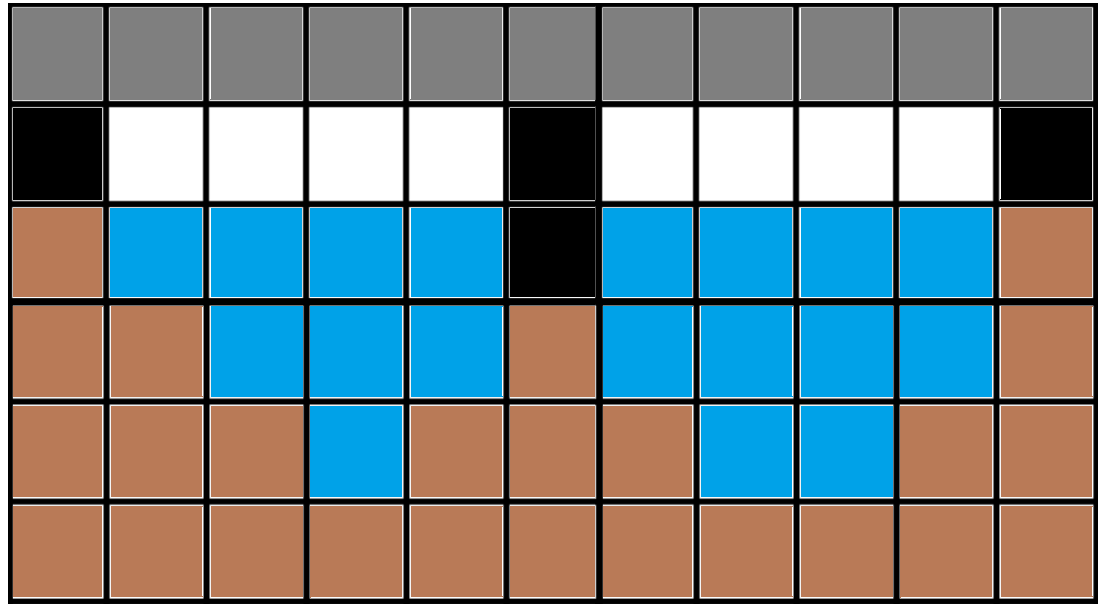| Codeforces Round 933 (Div. 3) |
|---|
| Finished |
Bernard loves visiting Rudolf, but he is always running late. The problem is that Bernard has to cross the river on a ferry. Rudolf decided to help his friend solve this problem.
The river is a grid of $$$n$$$ rows and $$$m$$$ columns. The intersection of the $$$i$$$-th row and the $$$j$$$-th column contains the number $$$a_{i,j}$$$ — the depth in the corresponding cell. All cells in the first and last columns correspond to the river banks, so the depth for them is $$$0$$$.
 The river may look like this.
The river may look like this. Rudolf can choose the row $$$(i,1), (i,2), \ldots, (i,m)$$$ and build a bridge over it. In each cell of the row, he can install a support for the bridge. The cost of installing a support in the cell $$$(i,j)$$$ is $$$a_{i,j}+1$$$. Supports must be installed so that the following conditions are met:
- A support must be installed in cell $$$(i,1)$$$;
- A support must be installed in cell $$$(i,m)$$$;
- The distance between any pair of adjacent supports must be no more than $$$d$$$. The distance between supports $$$(i, j_1)$$$ and $$$(i, j_2)$$$ is $$$|j_1 - j_2| - 1$$$.
Building just one bridge is boring. Therefore, Rudolf decided to build $$$k$$$ bridges on consecutive rows of the river, that is, to choose some $$$i$$$ ($$$1 \le i \le n - k + 1$$$) and independently build a bridge on each of the rows $$$i, i + 1, \ldots, i + k - 1$$$. Help Rudolf minimize the total cost of installing supports.
The first line contains a single integer $$$t$$$ $$$(1 \le t \le 10^3)$$$ — the number of test cases. The descriptions of the test cases follow.
The first line of each test case contains four integers $$$n$$$, $$$m$$$, $$$k$$$, and $$$d$$$ ($$$1 \le k \le n \le 100$$$, $$$3 \le m \le 2 \cdot 10^5$$$, $$$1 \le d \le m$$$) — the number of rows and columns of the field, the number of bridges, and the maximum distance between supports.
Then follow $$$n$$$ lines, $$$i$$$-th line contains $$$m$$$ positive integers $$$a_{i, j}$$$ ($$$0 \le a_{i, j} \le 10^6$$$, $$$a_{i, 1} = a_{i, m} = 0$$$) — the depths of the river cells.
It is guaranteed that the sum of $$$n \cdot m$$$ for all sets of input data does not exceed $$$2 \cdot 10^5$$$.
For each test case, output a single number — the minimum total cost of supports installation.
53 11 1 40 1 2 3 4 5 4 3 2 1 00 1 2 3 2 1 2 3 3 2 00 1 2 3 5 5 5 5 5 2 04 4 2 10 3 3 00 2 1 00 1 2 00 3 3 04 5 2 50 1 1 1 00 2 2 2 00 2 1 1 00 3 2 1 01 8 1 10 10 4 8 4 4 2 04 5 3 20 8 4 4 00 3 4 8 00 8 1 10 00 10 1 5 0
4 8 4 15 14
In the first test case, it is most profitable to build a bridge on the second row.
 It is not a top view, but side view: gray cells — bridge itself, white cells are empty, black cells — supports, blue cells — water, brown cells — river bottom.
It is not a top view, but side view: gray cells — bridge itself, white cells are empty, black cells — supports, blue cells — water, brown cells — river bottom. In the second test case, it is most profitable to build bridges on the second and third rows. The supports will be placed in cells $$$(2, 3)$$$, $$$(3, 2)$$$, and on the river banks.
In the third test case the supports can be placed along the river banks.
| Name |
|---|




